苏教版小学英语语法复习及练习
- 格式:doc
- 大小:68.00 KB
- 文档页数:13
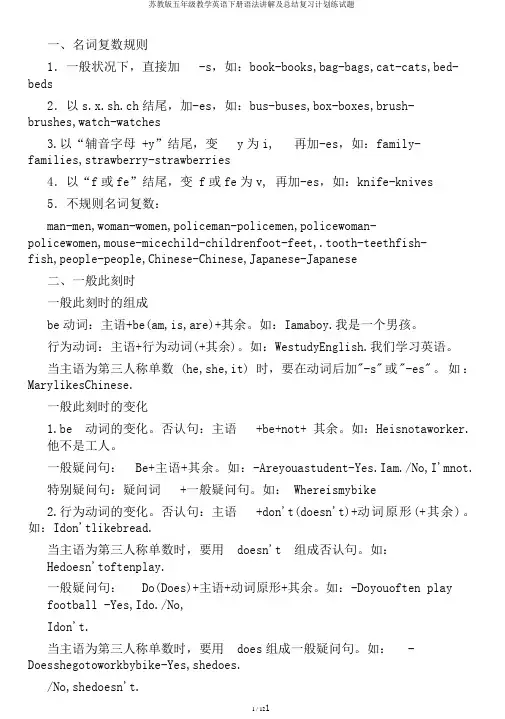
一、名词复数规则1.一般状况下,直接加-s,如:book-books,bag-bags,cat-cats,bed-beds2.以s.x.sh.ch 结尾,加-es,如:bus-buses,box-boxes,brush-brushes,watch-watches3.以“辅音字母+y”结尾,变y为i, 再加-es,如:family-families,strawberry-strawberries4.以“f或fe”结尾,变 f或fe为v, 再加-es,如:knife-knives5.不规则名词复数:man-men,woman-women,policeman-policemen,policewoman-policewomen,mouse-micechild-childrenfoot-feet,.tooth-teethfish-fish,people-people,Chinese-Chinese,Japanese-Japanese二、一般此刻时一般此刻时的组成be动词:主语+be(am,is,are)+其余。
如:Iamaboy.我是一个男孩。
行为动词:主语+行为动词(+其余)。
如:WestudyEnglish.我们学习英语。
当主语为第三人称单数 (he,she,it) 时,要在动词后加"-s"或"-es"。
如:MarylikesChinese.一般此刻时的变化1.be 动词的变化。
否认句:主语+be+not+ 其余。
如:Heisnotaworker.他不是工人。
一般疑问句:Be+主语+其余。
如:-Areyouastudent-Yes.Iam./No,I'mnot.特别疑问句:疑问词+一般疑问句。
如: Whereismybike2.行为动词的变化。
否认句:主语+don't(doesn't)+ 动词原形(+其余)。
如:Idon'tlikebread.当主语为第三人称单数时,要用doesn't 组成否认句。
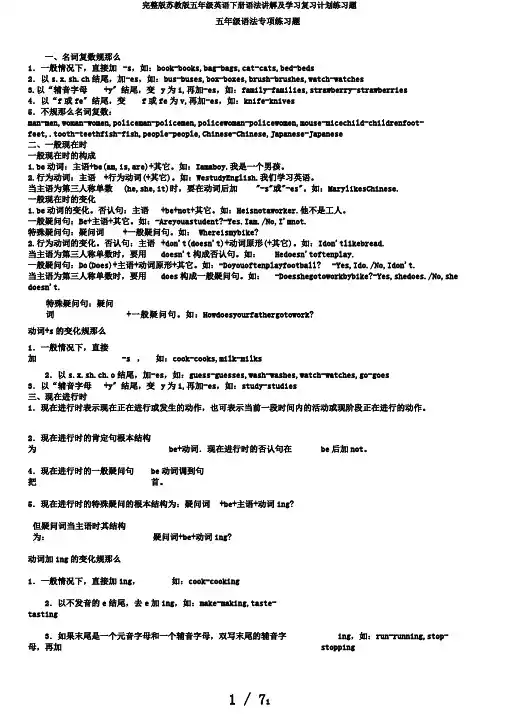
五年级语法专项练习题一、名词复数规那么1.一般情况下,直接加-s,如:book-books,bag-bags,cat-cats,bed-beds2.以s.x.sh.ch结尾,加-es,如:bus-buses,box-boxes,brush-brushes,watch-watches3.以“辅音字母+y〞结尾,变y为i,再加-es,如:family-families,strawberry-strawberries4.以“f或fe〞结尾,变f或fe为v,再加-es,如:knife-knives5.不规那么名词复数:man-men,woman-women,policeman-policemen,policewoman-policewomen,mouse-micechild-childrenfoot-feet,.tooth-teethfish-fish,people-people,Chinese-Chinese,Japanese-Japanese二、一般现在时一般现在时的构成1.be动词:主语+be(am,is,are)+其它。
如:Iamaboy.我是一个男孩。
2.行为动词:主语+行为动词(+其它)。
如:WestudyEnglish.我们学习英语。
当主语为第三人称单数(he,she,it)时,要在动词后加"-s"或"-es"。
如:MarylikesChinese.一般现在时的变化1.be动词的变化。
否认句:主语+be+not+其它。
如:Heisnotaworker.他不是工人。
一般疑问句:Be+主语+其它。
如:-Areyouastudent?-Yes.Iam./No,I'mnot.特殊疑问句:疑问词+一般疑问句。
如: Whereismybike?2.行为动词的变化。
否认句:主语+don't(doesn't)+动词原形(+其它)。
如:Idon'tlikebread.当主语为第三人称单数时,要用doesn't构成否认句。

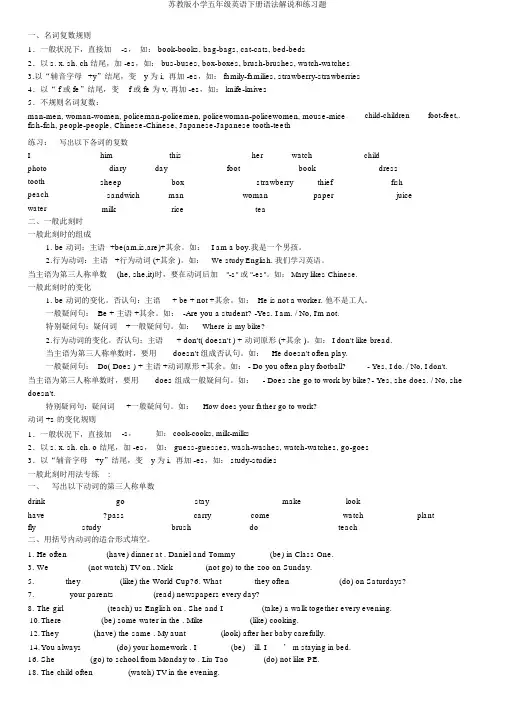
一、名词复数规则1.一般状况下,直接加-s,如: book-books, bag-bags, cat-cats, bed-beds2.以 s. x. sh. ch 结尾,加 -es,如: bus-buses, box-boxes, brush-brushes, watch-watches3.以“辅音字母+y”结尾,变y 为 i, 再加 -es,如: family-families, strawberry-strawberries4.以“ f 或 fe”结尾,变 f 或 fe 为 v, 再加 -es,如: knife-knives5.不规则名词复数:man-men, woman-women, policeman-policemen, policewoman-policewomen, mouse-micefish-fish, people-people, Chinese-Chinese, Japanese-Japanese tooth-teethchild-children foot-feet,.练习:写出以下各词的复数I _________ photo ________ tooth_______ peach______ water________him _________this ___________her ______watch _______child _______ diary ______day________foot________book_______dress ________ sheep ______box________strawberry _____thief _______fish______ sandwich ______man______woman_______paper_______juice___________ milk________rice__________tea__________二、一般此刻时一般此刻时的组成1. be 动词:主语2.行为动词:主语+be(am,is,are)+其余。
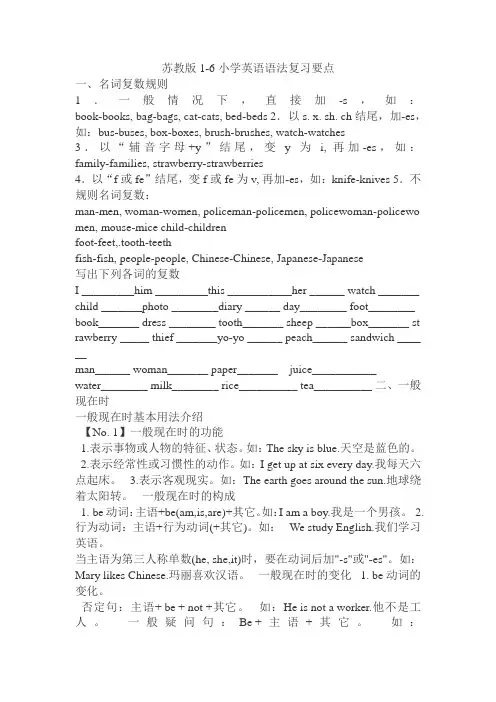
苏教版1-6小学英语语法复习要点一、名词复数规则1.一般情况下,直接加-s,如:book-books, bag-bags, cat-cats, bed-beds 2.以s. x. sh. ch结尾,加-es,如:bus-buses, box-boxes, brush-brushes, watch-watches3.以“辅音字母+y”结尾,变y为i, 再加-es,如:family-families, strawberry-strawberries4.以“f或fe”结尾,变f或fe为v, 再加-es,如:knife-knives 5.不规则名词复数:man-men, woman-women, policeman-policemen, policewoman-policewo men, mouse-mice child-childrenfoot-feet,.tooth-teethfish-fish, people-people, Chinese-Chinese, Japanese-Japanese写出下列各词的复数I _________him _________this ___________her ______ watch _______ child _______photo ________diary ______ day________ foot________ book_______ dress ________ tooth_______ sheep ______box_______ st rawberry _____ thief _______yo-yo ______ peach______ sandwich ____ __man______ woman_______ paper_______ juice___________water________ milk________ rice__________ tea__________ 二、一般现在时一般现在时基本用法介绍【No. 1】一般现在时的功能1.表示事物或人物的特征、状态。
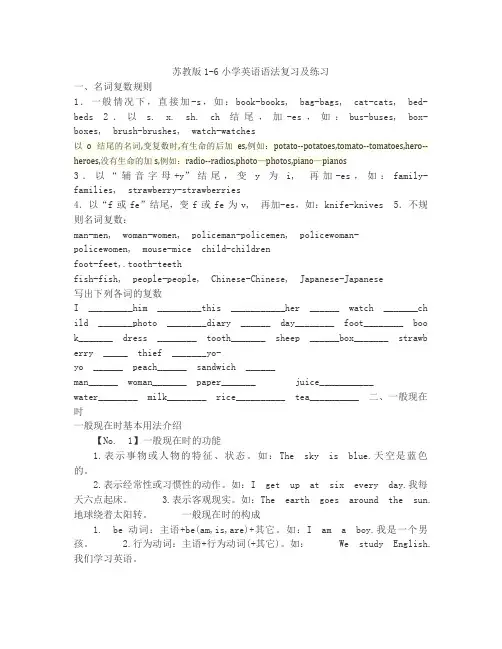
苏教版1-6小学英语语法复习及练习一、名词复数规则1.一般情况下,直接加-s,如:book-books, bag-bags, cat-cats, bed-beds 2.以s. x. sh. ch结尾,加-es,如:bus-buses, box-boxes, brush-brushes, watch-watches以o结尾的名词,变复数时,有生命的后加es,例如:potato--potatoes,tomato--tomatoes,hero--heroes,没有生命的加s,例如:radio--radios,photo—photos,piano—pianos3.以“辅音字母+y”结尾,变y为i, 再加-es,如:family-families, strawberry-strawberries4.以“f或fe”结尾,变f或fe为v, 再加-es,如:knife-knives 5.不规则名词复数:man-men, woman-women, policeman-policemen, policewoman-policewomen, mouse-mice child-childrenfoot-feet,.tooth-teethfish-fish, people-people, Chinese-Chinese, Japanese-Japanese写出下列各词的复数I _________him _________this ___________her ______ watch _______ch ild _______photo ________diary ______ day________ foot________ boo k_______ dress ________ tooth_______ sheep ______box_______ strawb erry _____ thief _______yo-yo ______ peach______ sandwich ______man______ woman_______ paper_______ juice___________water________ milk________ rice__________ tea__________ 二、一般现在时一般现在时基本用法介绍【No. 1】一般现在时的功能1.表示事物或人物的特征、状态。
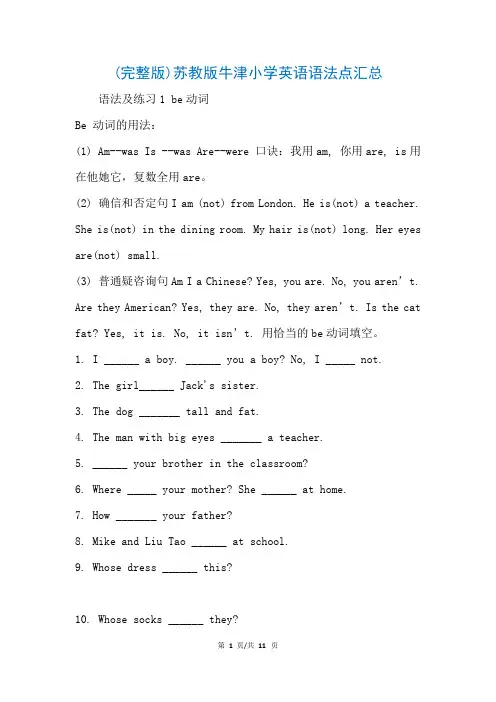
(完整版)苏教版牛津小学英语语法点汇总语法及练习1 be动词Be 动词的用法:(1) Am--was Is --was Are--were 口诀:我用am, 你用are, is用在他她它,复数全用are。
(2) 确信和否定句I am (not) from London. He is(not) a teacher. She is(not) in the dining room. My hair is(not) long. Her eyes are(not) small.(3) 普通疑咨询句Am I a Chinese? Yes, you are. No, you aren’t. Are they American? Yes, they are. No, they aren’t. Is the cat fat? Yes, it is. No, it isn’t. 用恰当的be动词填空。
1. I ______ a boy. ______ you a boy? No, I _____ not.2. The girl______ Jack's sister.3. The dog _______ tall and fat.4. The man with big eyes _______ a teacher.5. ______ your brother in the classroom?6. Where _____ your mother? She ______ at home.7. How _______ your father?8. Mike and Liu Tao ______ at school.9. Whose dress ______ this?10. Whose socks ______ they?11. That ______ my red skirt.12. Who ______ I?13.The jeans ______ on the desk.14. Here ______ a scarf for you.15. Here ______ some sweaters for you.16. The black gloves ______ for Su Yang.17. This pair of gloves ______ for Yang Ling.18. The two cups of milk _____ for me.19. Some tea ______ in the glass.20. Gao shan's shirt _______ over there.21. My sister's name ______Nancy.22. This ______ not Wang Fang's pencil.23. ______ David and Helen from England?24. There ______ a girl in the room.25. There ______ some apples on the tree.26. _______ there any kites in the classroom?27. _______ there any apple juice in the bottle?28. There _______ some bread on the plate.29. There _______ a boy, two girls, three men and ten women in the park.30. You, he and I ______ from China.语法及练习2 人称代词和物主代词人称代词和物主代词1.人称代词主格和宾格的区不:主格通常位于句中第一具动词之前(有时候位于than 之后),宾格普通位于动词或介词之后。

苏教版小学五年级英语语法归纳及语法练习 TTA standardization office【TTA 5AB- TTAK 08- TTA 2C】苏教版小学五年级英语语法归纳及语法练习情态动词一、 can, (could 过去式)1) 表示能力(体力、知识、技能)。
Can you lift this heavy box?(体力)Mary can speak three languages.(知识)Can you skate?(技能)Can只有一般现在时和一般过去式;2) 表示请求和允许。
-----Can I go now----- Yes, you can. / No, you can’t.3) 表示客观可能性(客观原因形成的能力)。
They’ve changed the timetable, so we can go by bus instead.This hall can hold 500 people at least.4) 表示推测(惊讶、怀疑、不相信的态度),用于疑问句、否定句和感叹句中。
Can this be trueThis can’t be done by him.How can this be true二.should,1) should,表示应该劝告、建议和命令。
1. I should help her because she is in trouble.1. You should go to class right away.2. Should I open the window3) 表示推测Should(客观推测) , must (主观推测)。
1. He must be home by now. (断定他已到家)2. He should be home by now.(不太肯定)(一) 用适当的情态动词填空。
1. Must I stand up No, you ________.2. ________ I speak something Yes, you ________.3. ________ I leave the park now No, you _________ stay here.4.My grandmother is ill. I _________ stay at home and look after her.5.________ you like some juice6. They ________ take more exercise.7. ________ you tell me the way to the museum8. The watch ________ tell us the right time.9. ________ you like to go boating with us10. ________ we play chess next weekend(二)按要求改写句子。

苏教版1-6小学英语语法复习要点一、名词复数规则1.一般情况下,直接加-s,如:book-books, bag-bags, cat-cats, bed-beds 2.以s. x. sh. ch结尾,加-es,如:bus-buses, box-boxes, brush-brushes, watch-watches3.以“辅音字母+y”结尾,变y为i, 再加-es,如:family-families, strawberry-strawberries4.以“f或fe”结尾,变f或fe为v, 再加-es,如:knife-knives 5.不规则名词复数:man-men, woman-women, policeman-policemen, policewoman-policewo men, mouse-mice child-childrenfoot-feet,.tooth-teethfish-fish, people-people, Chinese-Chinese, Japanese-Japanese写出下列各词的复数I _________him _________this ___________her ______ watch _______ child _______photo ________diary ______ day________ foot________ book_______ dress ________ tooth_______ sheep ______box_______ st rawberry _____ thief _______yo-yo ______ peach______ sandwich ____ __man______ woman_______ paper_______ juice___________water________ milk________ rice__________ tea__________ 二、一般现在时一般现在时基本用法介绍【No. 1】一般现在时的功能1.表示事物或人物的特征、状态。

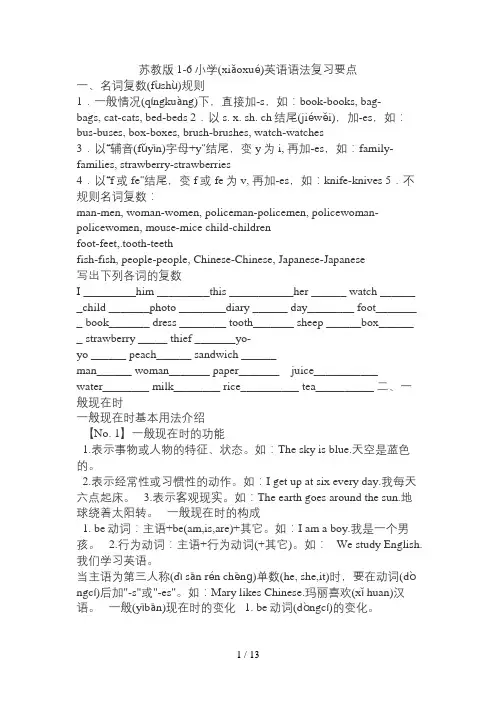
苏教版1-6小学(xiǎoxué)英语语法复习要点一、名词复数(fùshù)规则1.一般情况(qíngkuàng)下,直接加-s,如:book-books, bag-bags, cat-cats, bed-beds 2.以s. x. sh. ch结尾(jiéwěi),加-es,如:bus-buses, box-boxes, brush-brushes, watch-watches3.以“辅音(fǔyīn)字母+y”结尾,变y为i, 再加-es,如:family-families, strawberry-strawberries4.以“f或fe”结尾,变f或fe为v, 再加-es,如:knife-knives 5.不规则名词复数:man-men, woman-women, policeman-policemen, policewoman-policewomen, mouse-mice child-childrenfoot-feet,.tooth-teethfish-fish, people-people, Chinese-Chinese, Japanese-Japanese写出下列各词的复数I _________him _________this ___________her ______ watch ______ _child _______photo ________diary ______ day________ foot_______ _ book_______ dress ________ tooth_______ sheep ______box______ _ strawberry _____ thief _______yo-yo ______ peach______ sandwich ______man______ woman_______ paper_______ juice___________water________ milk________ rice__________ tea__________ 二、一般现在时一般现在时基本用法介绍【No. 1】一般现在时的功能1.表示事物或人物的特征、状态。
苏教版小学五年级英语语法归纳及语法练习情态动词一、 can, (could 过去式)1) 表示能力(体力、知识、技能)。
Can you lift this heavy box?(体力)Mary can speak three languages.(知识)Can you skate?(技能)Can只有一般现在时和一般过去式;2) 表示请求和允许。
-----Can I go now?----- Yes, you can. / No, you can’t.3) 表示客观可能性(客观原因形成的能力)。
They’ve changed the timetable, so we can go by bus instead.This hall can hold 500 people at least.4) 表示推测(惊讶、怀疑、不相信的态度),用于疑问句、否定句和感叹句中。
Can this be true?This can’t be done by him.How can this be true?二.should,1) should,表示应该劝告、建议和命令。
1. I should help her because she is in trouble.1. You should go to class right away.2. Should I open the window?3) 表示推测Should(客观推测) , must (主观推测)。
1. He must be home by now. (断定他已到家)2. He should be home by now.(不太肯定)(一) 用适当的情态动词填空。
1. Must I stand up? No, you ________.2. ________ I speak something? Yes, you ________.3. ________ I leave the park now? No, you _________ stay here.4. My grandmother is ill. I _________ stay at home and look after her.5. ________ you like some juice?6. They ________ take more exercise.7. ________ you tell me the way to the museum?8. The watch ________ tell us the right time.9. ________ you like to go boating with us?10. ________ we play chess next weekend?(二)按要求改写句子。
苏教版小学五年级英语下册语法讲解和练习题一、名词复数规则名词复数有以下几种规则:1.一般情况下直接加-s,例如:book-books,bag-bags,cat-cats,bed-beds。
2.以s。
x。
sh。
ch结尾的名词,加-es,例如:bus-buses,box-boxes,brush-brushes,watch-watches。
3.以“辅音字母+y”结尾的名词,变y为i,再加-es,例如:family-families,strawberry-strawberries。
4.以“f或fe”结尾的名词,变f或fe为v,再加-es,例如:knife-knives。
5.不规则名词复数有man-men,woman-women,policeman-policemen,policewoman-policewomen,mouse-mice,child-children,foot-feet,tooth-teeth,fish-fish,people-people,Chinese-Chinese,Japanese-Japanese。
二、一般现在时一般现在时的构成有以下几种情况:1.be动词:主语+be(am。
is。
are)+其它,例如:I am a boy.我是一个男孩。
2.行为动词:主语+行为动词(+其它),例如:XXX.我们研究英语。
当主语为第三人称单数(he。
she。
it)时,要在动词后加"-s"或"-es",例如:Mary likes Chinese.一般现在时的变化有以下几种情况:1.be动词的变化。
否定句:主语+be+not+其它,例如:He is not a worker.他不是工人。
一般疑问句:Be+主语+其它,例如:-Are you a student。
-Yes。
I am。
/ No。
I'm not.特殊疑问句:疑问词+一般疑问句,例如:Where is my bike?2.行为动词的变化。
Unit 1 In class在上课(红色为四会单词)单标:能使用简单的祈使句(肯定形式)表达一些上课时的交际用语。
一、词汇1.In class在上课2.please请3.open开4.close关上5.the这、这个6.door门7.sorry对不起e in 进来9.window窗户10.blackboard黑板 11.rubber橡皮12.parrot鹦鹉13.listen to听14.don’t=do not二、句型及语法1、习惯搭配/短语Good morning,class. 早上好,同学们。
Stand up. 起立Sit down, please. 请坐Open the door. 开门Close the window. 关窗Come in. 请进I’m sorry.对不起(用于表达歉意)Listen to…听…What’s this/that ?2、the/a/an的用法:定冠词the 用来特指人或事物。
所指的人或事物是同类中特定的一个。
意为“这个;这些;那个;那些”。
可以和单、复数名词,也可以和不可数名词连用。
例:the girl in red这个红衣女孩(许多的女孩中,特指这一个红衣女孩,而不是其他的女孩。
)不定冠词a用于读音以辅音音素开头的单词前,不定冠词an用于读音以元音音素开头的单词前。
例如: a bird (一只小鸟) a cake (一块蛋糕)an apple (一个苹果)an orange (一个橙子)同步练习:( )1.This is dog.A./B. anC. a( )2.I have orange cat. It's from my mother.A. a/B. anC.the( )3.Listen to man in black, please.A.anB. theC.a3、Mr.的用法对男士的尊称为 Mr. … (…先生)Mrs. 太太、夫人(是对已婚妇女的称呼)Miss 小姐(是对未婚妇女的称呼)4、询问“这/那是什么?”的句型及其答句问:What’s this(近处东西)/that(远处东西)? 答It’s a/an …☆5. 祈使句的肯定形式解析1.祈使句的用法(命令某人做某事)祈使句一般用来表示请求、命令或劝告,并根据语气的强弱,句末使用感叹号或in? 句号,朗读时常用降调。
苏教版1-6小学英语语法复习及练习一、名词复数规则1.一般情况下,直接加-s,如:book-books, bag-bags, cat-cats, bed-beds 2.以s. x. sh. ch结尾,加-es,如:bus-buses, box-boxes, brush-brushes, watch-watches以o结尾的名词,变复数时,有生命的后加es,例如:potato--potatoes,tomato--tomatoes,hero--heroes,没有生命的加s,例如:radio--radios,photo—photos,piano—pianos3.以“辅音字母+y”结尾,变y为i, 再加-es,如:family-families, strawberry-strawberries4.以“f或fe”结尾,变f或fe为v, 再加-es,如:knife-knives 5.不规则名词复数:man-men, woman-women, policeman-policemen, policewoman-policewomen, mouse-mice child-childrenfoot-feet,.tooth-teethfish-fish, people-people, Chinese-Chinese, Japanese-Japanese写出下列各词的复数I _________him _________this ___________her ______ watch _______ch ild _______photo ________diary ______ day________ foot________ boo k_______ dress ________ tooth_______ sheep ______box_______ strawb erry _____ thief _______yo-yo ______ peach______ sandwich ______man______ woman_______ paper_______ juice___________water________ milk________ rice__________ tea__________ 二、一般现在时一般现在时基本用法介绍【No. 1】一般现在时的功能1.表示事物或人物的特征、状态。
五上期末语法复习一、There be 句型陈述句:There is / are…1、There is a big playground on our school .There is an art room on the second floor .There is some soup on the table .There is not any soup on the table .(不可数名词: soup ,milk ,juice ,tea ,water ,rice ,bread, coffee)2、There are some bears in the forest .There aren’t any bears in the forest .(名词复数:a. +sb. +es: peaches, dresses, boxes, glasses, buses, watchesc. 辅音字母加y结尾的,改y为i+es:library -libraries,body-bodies, country-countries, hobby-hobbies,d. 特殊:woman-women, man-men,foot-feet, fish—fish, child-children)3、就近原则:There is a bed and three bears in the house .There are three bears and a bed in the house .4、There be 句型的一般疑问句形式:Be there…?单数:Is there a / an /any …?Is there a library in our school ?Is there any milk in the glass ?肯定回答: Yes, there is . 否定回答: No ,there aren’t .复数:Are there any ...?Are there any peaches on the tree ?肯定回答:Yes, there are . 否定回答:No, there aren’t .5、特殊疑问句: What’s +位置短语?(表示问某处有什么,用there be 句型回答)6、易错题:There is a pair of shoes under the bed .There are two shoes under the bed .(shoes , gloves, trousers, socks glasses(眼镜)等)7、某处没有什么,用no 和not表达不同:There is no egg in the fridge. There is not an egg in the fridge.There are no apples on the table. There are not any apples on the table.二、How many 句型用法:How many + 可数名词的复数,分两种情况:1、什么地方有多少什么? How many students are there in our classroom ?回答:There are forty –four students in our classroom .(注意:当答案为一个时用There is one.回答。
一、名词复数规则1.一般状况下,直接加-s,如: book-books, bag-bags, cat-cats, bed-beds2.以 s. x. sh. ch 结尾,加 -es,如: bus-buses, box-boxes, brush-brushes, watch-watches3.以“辅音字母+y”结尾,变y 为 i, 再加 -es,如: family-families, strawberry-strawberries4.以“ f 或 fe”结尾,变 f 或 fe 为 v, 再加 -es,如: knife-knives5.不规则名词复数:man-men, woman-women, policeman-policemen, policewoman-policewomen, mouse-mice child-children foot-feet,. tooth-teeth fish-fish, people-people, Chinese-Chinese, Japanese-Japanese二、一般此刻时一般此刻时的组成1. be 动词:主语 +be(am,is,are)+其余。
如: I am a boy.我是一个男孩。
2.行为动词:主语+行为动词 (+其余 )。
如: We study English. 我们学习英语。
当主语为第三人称单数(he, she,it)时,要在动词后加"-s" 或 "-es"。
如: Mary likes Chinese.一般此刻时的变化1. be 动词的变化。
否认句:主语+ be + not +其余。
如: He is not a worker. 他不是工人。
一般疑问句: Be + 主语 +其余。
如: -Are you a student? -Yes. I am. / No, I'm not.特别疑问句:疑问词+一般疑问句。
苏教版1-6小学英语语法复习及练习一、名词复数规则1.一般情况下,直接加-s,如:book-books, bag-bags, cat-cats, bed-beds 2.以s. x. sh. ch结尾,加-es,如:bus-buses, box-boxes, brush-brushes, watch-watches以o结尾的名词,变复数时,有生命的后加es,例如:potato--potatoes,tomato--tomatoes,hero--heroes,没有生命的加s,例如:radio--radios,photo—photos,piano—pianos3.以“辅音字母+y”结尾,变y为i, 再加-es,如:family-families, strawberry-strawberries4.以“f或fe”结尾,变f或fe为v, 再加-es,如:knife-knives 5.不规则名词复数:man-men, woman-women, policeman-policemen, policewoman-policewomen, mouse-mice child-childrenfoot-feet,.tooth-teethfish-fish, people-people, Chinese-Chinese, Japanese-Japanese写出下列各词的复数I _________him _________this ___________her ______ watch _______ch ild _______photo ________diary ______ day________ foot________ boo k_______ dress ________ tooth_______ sheep ______box_______ strawb erry _____ thief _______yo-yo ______ peach______ sandwich ______man______ woman_______ paper_______ juice___________water________ milk________ rice__________ tea__________ 二、一般现在时一般现在时基本用法介绍【No. 1】一般现在时的功能1.表示事物或人物的特征、状态。
如:The sky is blue.天空是蓝色的。
2.表示经常性或习惯性的动作。
如:I get up at six every day.我每天六点起床。
3.表示客观现实。
如:The earth goes around the sun.地球绕着太阳转。
一般现在时的构成1. be动词:主语+be(am,is,are)+其它。
如:I am a boy.我是一个男孩。
2.行为动词:主语+行为动词(+其它)。
如:We study English.我们学习英语。
当主语为第三人称单数(he, she,it)时,要在动词后加"-s"或"-es"。
如:Mary likes Chinese.玛丽喜欢汉语。
一般现在时的变化 1. be动词的变化。
否定句:主语+ be + not +其它。
如:He is not a worker.他不是工人。
一般疑问句:Be +主语+其它。
如:-Are you a student? -Yes. I am. / No, I'm not.特殊疑问句:疑问词+一般疑问句。
如:Where is my bike? 2.行为动词的变化。
否定句:主语+ don't( doesn't ) +动词原形(+其它)。
如:I don't like bread.当主语为第三人称单数时,要用doesn't构成否定句。
如:He doesn't often play.一般疑问句:Do( Does ) +主语+动词原形+其它。
如:-Do you often play football? -Yes, I do. / No, I don't.当主语为第三人称单数时,要用does构成一般疑问句。
如:-Does she go to work by bike? -Yes, she does. / No, she doesn't.特殊疑问句:疑问词+一般疑问句。
如:How does your father go to work? 动词+s的变化规则1.一般情况下,直接加-s,如:cook-cooks, milk-milks2.以s. x. sh. ch. o结尾,加-es,如:guess-guesses, wash-washes, watch-watches, go-goes3.以“辅音字母+y”结尾,变y为i, 再加-es,如:study-studies 一般现在时用法专练:一、写出下列动词的第三人称单数drink ________ go _______ stay ________ make ________ look ____ _____ have_______ pass_______ carry ____come________ watch______ plant_______ fly ________study_______ brush________ do_________ teach_______二、用括号内动词的适当形式填空。
1. He often ________(have) dinner at home. 2. Daniel and Tommy _______(be) in Class One. 3. We _______(not watch) TV on Monday. 4. Nick _______(not go) to the zoo on Sunday. 5. ______ they ________(like) the World Cup?6. What _______they often _______(do) on Saturdays?7. _______ your parents _______(read) newspapers every day? 8. The girl _______(teach) us English on Sundays.9. She and I ________(take) a walk together every evening. 10. There ________(be) some water in the bottle. 11. Mike _______ (like) cooking.12. They _______(have) the same hobby.13. My aunt _______(look) after her baby carefully. 14. You al ways _______(do) your homework well. 15. I _______(be) ill. I’m staying in bed.16. She _______(go) to school from Monday to Friday. 17. Liu Tao _______(do) not like PE.18. The child often _______(watch) TV in the evening.19. Su Hai and Su Yang _______(have) eight lessons this term.20. -What day _______(be) it today? -It’s Saturday.三、按照要求改写句子1. Daniel watches TV every evening.(改为否定句)___________________________________________________ 2. I do my home work every day.(改为一般疑问句,作否定回答) ________________________________________________________ _________ ___________________3. She likes milk.(改为一般疑问句,作肯定回答)_______________________________________________________ _______________ _____________4. Amy likes playing computer games.(改为一般疑问句,作否定回答) ________________________________________________________ _________ ___________________________5. We go to school every morning.(改为否定句)_______________________________________________________6. He speaks English very well.(改为否定句)___________________________________________________7. I like taking photos in the park.(对划线部分提问)8. John comes from Canada.(对划线部分提问)___________________________________________________9. She is always a good student.(改为一般疑问句,作否定回答) ________________________________________________________10. Simon and Daniel like going skating.(改为否定句)___________________________________________________ 五、改错(划出错误的地方,将正确的写在横线上)1. Is your brother speak English? __________________2. Does he likes going fishing? __________________3. He likes play games after class. _________________ _4. Mr. Wu teachs us English. __________ ________5. She don’t do her homework on Sundays. ____________ _____ 三、现在进行时1.现在进行时表示现在正在进行或发生的动作,也可表示当前一段时间内的活动或现阶段正在进行的动作。